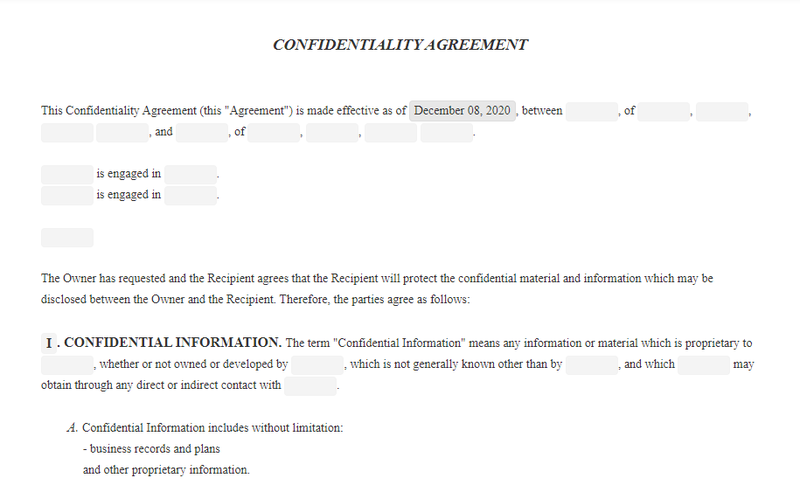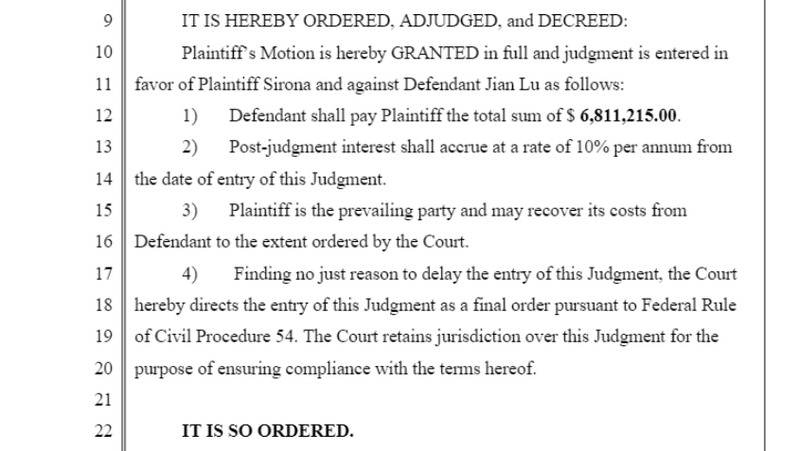Confidentiality agreements, also called nondisclosure agreements or NDAs, are important tools for protecting your company’s proprietary information. But they can also create legal liabilities of their own.
Just ask Amazon, which is fending off numerous complaints over NDAs the company reportedly asked employees to sign before being sent home for COVID-19. The complaints, filed with the Occupational Safety and Health Administration (OSHA), charge Amazon with silencing employees regarding the virus, exposing other employees to added risks.
So when should you use confidentiality agreements, and what should they contain? Find out what you need to know to protect your company’s information assets.
Overview: What is a confidentiality agreement?
A confidentiality agreement is a contract requiring someone to keep certain information secret. It can be a unilateral agreement binding the recipient to secrecy or a bilateral one, also called a mutual or reciprocal agreement, binding both parties.
Businesses use confidentiality agreements to protect sensitive information they need to share with employees, partners, suppliers, independent contractors, and others. This includes client lists, suppliers, pricing and sales data, terms of business deals, financial information, strategic plans, research, and intellectual property such as product designs, software documentation, and drawings.
These are all legitimate uses for a confidentiality statement or NDA. Where businesses tend to run into trouble is by creating agreements that:
• Are overly broad
• Are one-sided
• Infringe on someone’s legal rights
In Amazon’s case, the complaints allege a combination of all three errors.
Let’s take a closer look at how to use NDAs appropriately and avoid these mistakes.
Confidentiality agreement vs. nondisclosure agreement: What’s the difference?
There is no difference between confidentiality agreements and nondisclosure agreements. They may also be called confidential disclosure agreements or secrecy agreements.
Confidentiality clauses can be included in broader contracts. For example, a partnership agreement might include a paragraph stipulating that the terms of the partnership are confidential.
NDAs are often used along with non-compete agreements and employment contracts. A human resources (HR) document management plan can help you keep track of all of your NDA forms and other employee paperwork.
3 benefits of a confidentiality agreement
A confidentiality agreement provides these critical protections for your business.
1. Protects your competitive edge
You work hard to keep your business one step ahead of the competition, and confidentiality agreements are designed to help you stay there.
For example, if your competitors had access to your client list, they could turn it into their own prospecting list. If they had access to your pricing, they could simply undercut you. If the details of a business deal were released prematurely, the deal could fall through.
2. Safeguards sensitive data
Companies have to disclose a lot of sensitive information to do business. Employees, suppliers, consultants, financial advisors, and business partners may learn a lot about your finances, plans, and performance. Confidentiality agreements let everyone know what information can be shared and when it’s OK to share it.
3. Maintains your privacy
You can also use confidentiality agreements to keep business arrangements private. For example, you might make an early retirement offer to an employee, or you might want to explore investing in another company or forging a joint venture. It makes sense to keep some aspects of your business confidential.

5 situations when you should use a confidentiality agreement
Here are five situations when a confidentiality agreement makes sense.
Hiring and offboarding employees
It’s important to include an employee confidentiality agreement as part of your hiring documentation. Employees get to know your company intimately, and they don’t always think about the potential consequences of oversharing. How much damage could result if an employee posted confidential information on a blog?
You should also require an NDA when terminating employees. An unhappy employee who downloads all their files before heading out the door is a major liability.
Human resources software can help you manage all these documents effectively.
Resolving disputes
No matter how carefully you manage relationships with employees, clients, and partners, your business can’t keep everyone happy all the time. When disputes escalate to the point of a formal settlement, the terms should include a confidentiality agreement. This gives your company closure and encourages everyone to move on.
Hiring independent contractors
Confidentiality agreements are even more important when contracting with independent workers, freelancers, and consultants because they often work with multiple clients in the same industry.
Entering partnerships and other ventures
Anytime you’re negotiating a partnership, co-marketing relationship, merger, acquisition, licensing agreement, or other business arrangement, all parties should sign a mutual NDA. The agreement should cover the terms of the deal as well as any confidential information you exchange while exploring and negotiating it.
Soliciting proposals
When seeking proposals from vendors such as software developers, engineering firms, or contractors, it is common to include an NDA because so much proprietary information needs to change hands.
…and 2 situations when you should not use an NDA
Confidentiality agreements should not be used for these purposes.
Covering up misconduct
Unfortunately, some businesses have used nondisclosure agreements to silence victims of sexual harassment and other misconduct. The #MeToo movement outing sexual harassers was fueled in part by misuse of NDAs.
A best practice at this point would be to refrain from requesting a nondisclosure agreement related to sexual harassment or other corporate misconduct unless the employee requests it. If you find that someone has been victimized at work, focus on responding appropriately, being transparent, and making the employee whole rather than running damage control.
For pitches and interviews
If you want to pitch an investor or business partner with an idea, don’t ask for a confidentiality agreement upfront. Similarly, asking an employee to sign an NDA covering their job interview feels invasive. Nobody wants to sign a legal document when there’s nothing on the table.
In these kinds of situations, it’s better to stick to the big picture and save the trade secrets for a later stage when you have confirmed interest on both sides.
How to write a confidentiality agreement
You can find free confidentiality agreement templates online, but downloading them and filling in the blanks is unlikely to give you the protection you need for two reasons.
One, your agreement is a communication vehicle. You can’t just put people on alert and expect them to be as discreet with your information as you would be. You have to spell out what information you’re talking about and how it should be handled. The more specific you are, the more likely they are to comply.
Two, as legal contracts go, confidentiality agreements are notoriously weak. If you want an agreement with legal teeth, you have to be specific. Courts have refused to enforce agreements that were overly broad or open-ended.
On the other hand, a properly drafted NDA can inflict a serious bite. Consider the 2017 verdict in Sirona Dental Systems v. Jian Lu et al. Lu took a senior engineering position with Sirona following an acquisition. Two years later, he resigned and took the company’s latest imaging system designs with him, marketing them through two companies in China. Lu was ordered to pay $6.8 million in damages for violating his NDA.

Here are some tips for going beyond NDA samples and basic contract templates to create effective agreements.
6 best practices when writing a confidentiality agreement
These best practices will help you create actionable, enforceable confidentiality agreements.
1. Define confidential information
Your agreement should specify what information it’s covering. Looking back at Amazon’s COVID-19 NDAs, they reportedly referenced “business information,” which could cover just about any aspect of working at the company.
When drafting an agreement, ask yourself what information you’re really trying to protect. Client lists, prices, product designs, market research, major purchases, strategic plans, sales performance? If you’re not sure, how can you expect someone else to know?
Confidentiality agreements also define what kinds of information are excluded. Generally, you cannot protect information someone receives if:
• It has already been revealed to the recipient
• It is publicly available
• The recipient could discover it through other means
• It is revealed by a third party
• The recipient creates it independently
2. Define permitted use
Your agreement should define any permissible use of confidential information. Can it be shared for certain purposes, or with certain people? For example, can your sales team share pricing information with certain business partners? Can your operations staff share monthly performance reports with your advertising agency?
3. Specify the duration
Your agreement should state how long it will apply. Even if it is a broad range such as five years, that’s better than nothing. If it has to be perpetual, then state that. At least then you can show that the signer understood your expectations.
It’s important to have a document retention strategy to match the expiration dates of your agreements. For example, many HR documents must be retained for specific periods. A document management system makes handling all of that paperwork much easier.
4. Provide consideration
Like any other contract, a confidentiality agreement requires consideration, compensation given in exchange for signing the agreement. When hiring employees, the consideration is the job. With a departing employee, it’s the severance package or settlement benefits. For a business partner, the consideration is usually the benefit of the arrangement.
This was the second red flag with Amazon’s COVID NDAs: They were given to existing employees. Since they already had jobs with the company, there was no consideration for signing a new agreement. If you’re asking an employee to sign a new agreement, you need to provide fresh consideration.
5. Consider the signer’s rights
In addition to sexual harassment laws, you need to ensure that your confidentiality agreements steer clear of other worker protection laws. Employees have a right to communicate about unsafe working conditions under the Occupational Safety and Health Act. Once again, we can look to the Amazon example, where OSHA saw potential safety risks in preventing employees from communicating about COVID.
Your employees also have a right to communicate about workplace conditions such as pay and working hours under the National Labor Relations Act (NLRA).
Your confidentiality agreement can’t prevent employees from engaging in these protected communications. Many agreements address this by specifically carving out speech covered under the relevant laws.
6. Prescribe consequences
Your agreement should spell out what will happen if the agreement is breached. While confidentiality agreements are hard to enforce, having clear consequences will encourage compliance and make it easier to prevail if you do wind up in court.
Consequences could include loss of privileges, monetary damages, injunctions to prevent further disclosures, and legal action.
Frequently Asked Questions for Confidentiality Agreements
What is a confidentiality agreement?
A confidentiality agreement is a contract requiring someone to keep certain information private. Businesses use confidentiality agreements to protect pricing, product designs, client lists, strategic plans, research, and other information assets.
Are confidentiality agreements enforceable?
Yes, confidentiality agreements are legally binding contracts that can be enforced by the courts. Like any contract, they must meet criteria such as informed consent, consideration, and legality. Confidentiality agreements may be declared unenforceable if they are overly broad or if they infringe on laws such as the Occupational Safety and Health Act and the National Labor Relations Act.
When should I use a confidentiality agreement?
Businesses should use confidentiality agreements when hiring and terminating employees; contracting with freelancers, consultants, and other independent workers; and entering partnerships, joint ventures, mergers, and other business relationships.
Protect your information
Every day, your business is researching, learning, creating, and planning. Confidentiality agreements are designed to protect all of the vital information you develop along the way, but they must be carefully crafted to work as intended. Consult with a legal adviser to assess your risks and create agreements that will protect your company’s hard-earned secrets.
The post Confidentiality Agreements: How, Why, and When to Use Them appeared first on The blueprint and is written by Elizabeth Gonzalez
Original source: The blueprint


